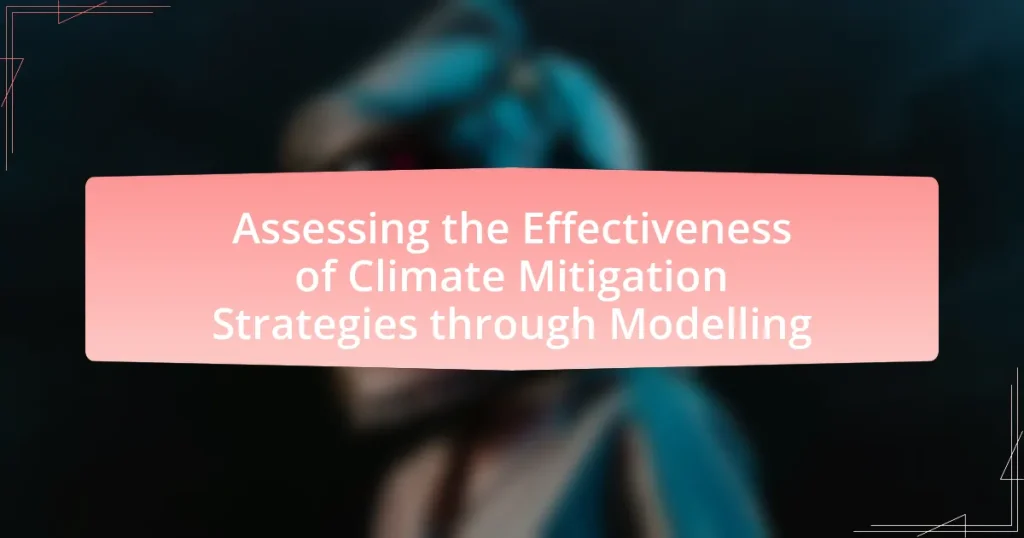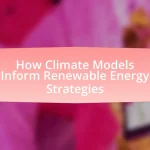Climate mitigation strategies are essential actions aimed at reducing greenhouse gas emissions and enhancing carbon sinks to address climate change. This article examines the effectiveness of these strategies through modeling, highlighting key types such as renewable energy adoption, energy efficiency improvements, and carbon capture technologies. It discusses the importance of assessing these strategies using various metrics, the role of modeling in predicting outcomes, and the challenges faced in measurement. Additionally, it explores current trends in modeling, advancements in technology, and case studies that illustrate successful applications, ultimately emphasizing best practices for effective climate action.
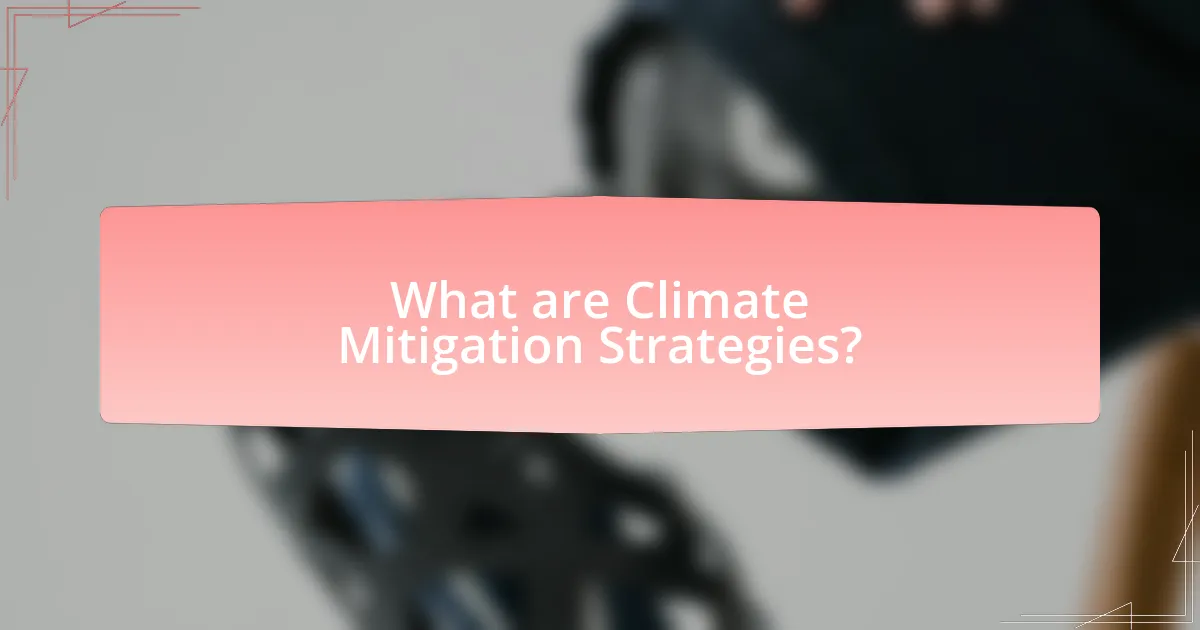
What are Climate Mitigation Strategies?
Climate mitigation strategies are actions aimed at reducing greenhouse gas emissions and enhancing carbon sinks to combat climate change. These strategies include transitioning to renewable energy sources, improving energy efficiency, promoting sustainable land use practices, and implementing carbon capture and storage technologies. For instance, the International Energy Agency reported that transitioning to renewable energy could reduce global CO2 emissions by up to 70% by 2050. Additionally, reforestation and afforestation can significantly enhance carbon sequestration, further contributing to climate mitigation efforts.
How do Climate Mitigation Strategies impact global warming?
Climate mitigation strategies significantly reduce global warming by decreasing greenhouse gas emissions. These strategies, such as transitioning to renewable energy sources, enhancing energy efficiency, and implementing carbon capture technologies, directly lower the concentration of carbon dioxide and other heat-trapping gases in the atmosphere. For instance, the International Energy Agency reported that a shift to renewable energy could cut global CO2 emissions by up to 70% by 2050. Additionally, the Intergovernmental Panel on Climate Change emphasizes that aggressive climate policies can limit global temperature rise to below 2 degrees Celsius, which is crucial for avoiding severe climate impacts. Thus, effective climate mitigation strategies are essential for curbing global warming and promoting environmental sustainability.
What are the primary types of Climate Mitigation Strategies?
The primary types of climate mitigation strategies include renewable energy adoption, energy efficiency improvements, carbon capture and storage, reforestation, and sustainable agriculture practices. Renewable energy adoption, such as solar and wind power, reduces reliance on fossil fuels, which are major greenhouse gas emitters. Energy efficiency improvements in buildings and transportation can significantly lower energy consumption and emissions. Carbon capture and storage technologies aim to capture CO2 emissions from industrial sources and store them underground, preventing their release into the atmosphere. Reforestation enhances carbon sequestration by increasing forest cover, while sustainable agriculture practices reduce emissions from farming activities. Collectively, these strategies are essential for achieving global climate targets and mitigating the impacts of climate change.
Why is it important to assess these strategies?
Assessing climate mitigation strategies is crucial for determining their effectiveness in reducing greenhouse gas emissions and achieving sustainability goals. Effective assessment allows policymakers to identify which strategies yield the best results, optimize resource allocation, and enhance overall climate resilience. For instance, a study by the Intergovernmental Panel on Climate Change (IPCC) highlights that rigorous evaluation of mitigation strategies can lead to a 40-70% reduction in emissions by 2050, demonstrating the tangible benefits of informed decision-making.
What role does modelling play in assessing these strategies?
Modelling plays a critical role in assessing climate mitigation strategies by providing a structured framework to simulate and evaluate the potential impacts of various interventions. Through quantitative analysis, models can predict outcomes based on different scenarios, allowing policymakers to understand the effectiveness and feasibility of strategies such as carbon pricing, renewable energy adoption, and energy efficiency improvements. For instance, integrated assessment models (IAMs) combine economic, environmental, and technological factors to project future emissions and climate impacts, demonstrating how specific strategies can achieve targeted reductions in greenhouse gas emissions. This evidence-based approach enables stakeholders to make informed decisions, prioritize actions, and allocate resources effectively, ultimately enhancing the overall effectiveness of climate mitigation efforts.
How can modelling help predict the outcomes of Climate Mitigation Strategies?
Modelling can predict the outcomes of climate mitigation strategies by simulating various scenarios and analyzing their potential impacts on greenhouse gas emissions and climate change. These models incorporate data on emissions sources, climate systems, and socio-economic factors, allowing researchers to evaluate the effectiveness of different strategies, such as renewable energy adoption or carbon pricing. For instance, the Integrated Assessment Models (IAMs) have been used to project the long-term effects of policy interventions, demonstrating that a 50% reduction in emissions by 2030 could limit global warming to 1.5 degrees Celsius, as outlined in the Intergovernmental Panel on Climate Change (IPCC) reports. This evidence supports the utility of modelling in informing policy decisions and optimizing climate action.
What are the limitations of using modelling for this purpose?
The limitations of using modelling to assess the effectiveness of climate mitigation strategies include oversimplification of complex systems, reliance on uncertain data, and potential biases in model assumptions. Oversimplification occurs when models fail to capture the intricate interactions within ecological and economic systems, leading to inaccurate predictions. Reliance on uncertain data can result in flawed outputs, as many climate models depend on projections that may not accurately reflect future conditions. Additionally, biases in model assumptions can skew results, as different models may prioritize certain variables over others, affecting the overall assessment of mitigation strategies. These limitations highlight the need for careful interpretation of model outputs and consideration of multiple scenarios in climate policy planning.
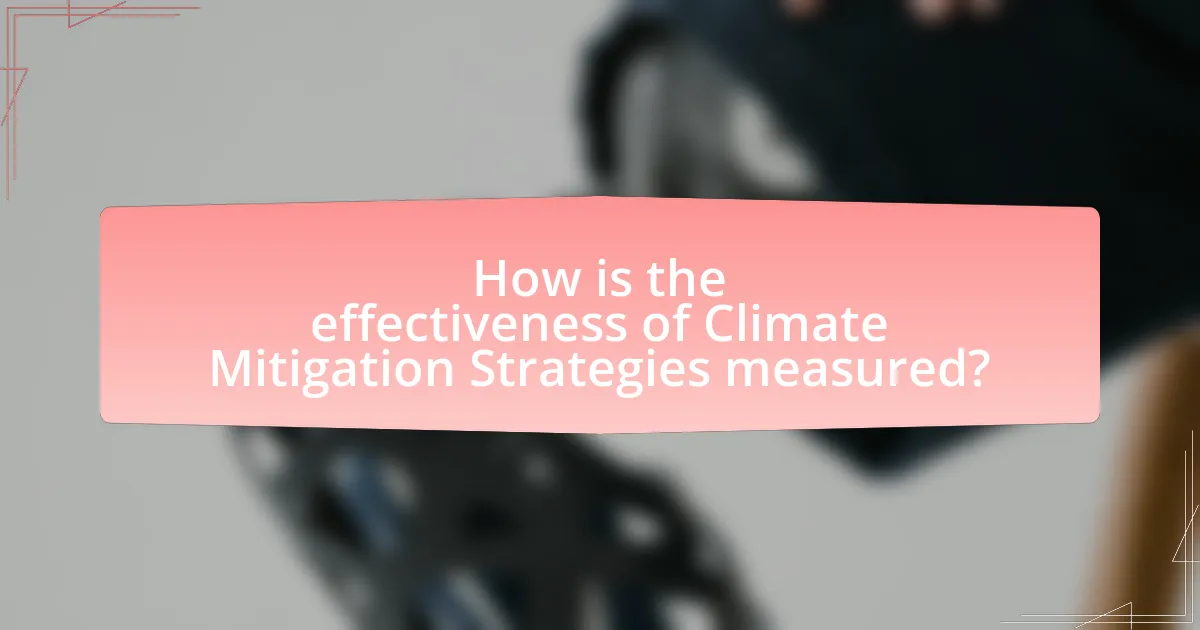
How is the effectiveness of Climate Mitigation Strategies measured?
The effectiveness of Climate Mitigation Strategies is measured through various quantitative and qualitative metrics, including greenhouse gas emissions reductions, cost-effectiveness, and social impact assessments. These metrics provide a comprehensive evaluation of how well strategies achieve their intended goals. For instance, the Intergovernmental Panel on Climate Change (IPCC) emphasizes the importance of tracking emissions data to assess progress towards targets set in international agreements like the Paris Agreement. Additionally, cost-benefit analyses are often employed to determine the economic viability of different strategies, while social impact assessments evaluate the broader implications on communities and ecosystems.
What metrics are used to evaluate effectiveness?
Metrics used to evaluate effectiveness in assessing climate mitigation strategies include greenhouse gas (GHG) emissions reductions, cost-effectiveness, and social co-benefits. GHG emissions reductions quantify the decrease in emissions achieved by a strategy, providing a direct measure of its impact on climate change. Cost-effectiveness assesses the economic efficiency of the strategy, often expressed as the cost per ton of CO2 equivalent reduced. Social co-benefits evaluate additional positive outcomes, such as improved public health or job creation, which enhance the overall value of the mitigation strategy. These metrics are essential for determining the success and viability of climate interventions.
How do these metrics vary across different strategies?
Metrics such as carbon emissions reduction, cost-effectiveness, and social impact vary significantly across different climate mitigation strategies. For instance, renewable energy strategies typically show higher carbon emissions reductions compared to fossil fuel-based strategies, with studies indicating that solar and wind energy can reduce emissions by up to 80% compared to coal. Cost-effectiveness also differs; energy efficiency measures often yield higher returns on investment than large-scale renewable projects, with some analyses showing that every dollar spent on energy efficiency can save up to four dollars in energy costs. Additionally, social impact metrics, including job creation and public health benefits, vary; strategies focused on green infrastructure can create more jobs per dollar invested than traditional infrastructure projects, with reports indicating that green jobs can outnumber fossil fuel jobs by a factor of three in certain regions.
What challenges arise in measuring these metrics?
Measuring the effectiveness of climate mitigation strategies presents several challenges, primarily due to the complexity and variability of environmental systems. One significant challenge is the difficulty in obtaining accurate and consistent data across different geographical regions and time periods, which can lead to discrepancies in metric evaluation. For instance, the Intergovernmental Panel on Climate Change (IPCC) highlights that variations in local climate conditions and socio-economic factors can significantly affect the outcomes of mitigation strategies, complicating the assessment process. Additionally, the integration of diverse data sources, such as satellite observations and ground-based measurements, often results in inconsistencies that hinder reliable metric calculation. Furthermore, the long-term nature of climate impacts makes it challenging to attribute specific changes directly to mitigation efforts, as natural variability can obscure the effects of human interventions. These factors collectively contribute to the difficulties in accurately measuring the metrics associated with climate mitigation strategies.
What are the key factors influencing the effectiveness of these strategies?
The key factors influencing the effectiveness of climate mitigation strategies include policy frameworks, technological advancements, stakeholder engagement, and economic incentives. Policy frameworks establish regulatory environments that guide implementation, as seen in the Paris Agreement, which sets binding targets for emissions reductions. Technological advancements, such as renewable energy technologies, enhance the feasibility and efficiency of strategies, evidenced by the significant cost reductions in solar and wind energy over the past decade. Stakeholder engagement ensures community support and participation, which is critical for the success of local initiatives, as demonstrated by successful grassroots movements in various regions. Economic incentives, including carbon pricing and subsidies for clean technologies, motivate businesses and individuals to adopt sustainable practices, supported by studies showing that countries with carbon pricing mechanisms have lower emissions.
How do socio-economic factors affect the outcomes?
Socio-economic factors significantly influence the outcomes of climate mitigation strategies by determining resource allocation, public engagement, and policy effectiveness. For instance, higher income levels often correlate with greater investment in sustainable technologies and practices, while lower socio-economic status may limit access to such resources, leading to disparities in environmental impact. Research indicates that communities with robust economic structures are more likely to adopt and implement effective climate policies, as seen in the Global Climate Change Report, which highlights that wealthier nations contribute more to emissions reduction efforts due to their capacity for innovation and investment. Additionally, socio-economic disparities can affect public awareness and participation in climate initiatives, further impacting the overall success of mitigation strategies.
What environmental variables must be considered?
Key environmental variables that must be considered include temperature, precipitation, humidity, and atmospheric composition. These variables significantly influence climate patterns and ecosystem dynamics, which are critical for assessing the effectiveness of climate mitigation strategies. For instance, temperature changes can affect species distribution and agricultural productivity, while alterations in precipitation patterns can impact water availability and soil health. Additionally, atmospheric composition, including greenhouse gas concentrations, directly correlates with climate change effects and mitigation outcomes. Understanding these variables is essential for accurate modeling and effective strategy implementation.
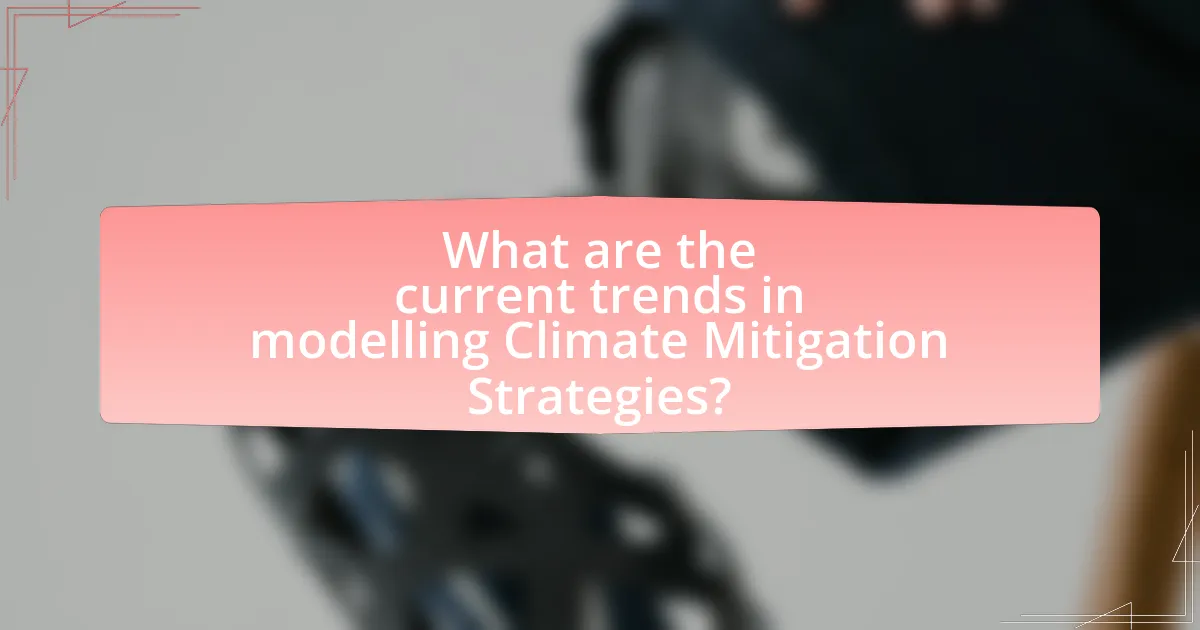
What are the current trends in modelling Climate Mitigation Strategies?
Current trends in modeling climate mitigation strategies include the integration of machine learning techniques, the use of scenario analysis, and the incorporation of socio-economic factors. Machine learning enhances predictive accuracy by analyzing vast datasets to identify patterns and optimize strategies. Scenario analysis allows stakeholders to evaluate the potential impacts of various policy options under different future conditions, facilitating informed decision-making. Additionally, incorporating socio-economic factors ensures that models reflect real-world complexities, improving their relevance and effectiveness. These trends are supported by research indicating that advanced modeling approaches lead to more robust and actionable climate strategies.
How have advancements in technology improved modelling accuracy?
Advancements in technology have significantly improved modelling accuracy by enhancing computational power, data collection methods, and algorithm sophistication. High-performance computing allows for the processing of complex models with vast datasets, leading to more precise simulations. For instance, the use of supercomputers has enabled climate models to incorporate finer spatial resolutions and more variables, resulting in improved predictions of climate patterns. Additionally, advancements in remote sensing technologies have facilitated the collection of real-time environmental data, which enhances the calibration and validation of models. Machine learning algorithms further refine modelling accuracy by identifying patterns in large datasets that traditional methods may overlook, as evidenced by their application in predicting climate impacts with greater reliability.
What new modelling techniques are being developed?
New modelling techniques being developed for assessing climate mitigation strategies include machine learning algorithms, integrated assessment models (IAMs), and agent-based models (ABMs). Machine learning algorithms enhance predictive accuracy by analyzing large datasets to identify patterns in climate data. Integrated assessment models combine economic, environmental, and social factors to evaluate the impacts of various mitigation strategies, allowing for comprehensive scenario analysis. Agent-based models simulate interactions among individual agents, providing insights into the dynamics of climate systems and human behavior. These advancements are supported by recent studies, such as the 2022 report by the Intergovernmental Panel on Climate Change, which emphasizes the importance of innovative modelling approaches in understanding and addressing climate change effectively.
How do these advancements impact policy-making?
Advancements in climate modeling significantly impact policy-making by providing data-driven insights that inform decision-making processes. These models enable policymakers to simulate various climate scenarios, assess the potential effectiveness of different mitigation strategies, and evaluate the long-term consequences of policy choices. For instance, the use of integrated assessment models has been instrumental in quantifying the economic and environmental impacts of carbon pricing, leading to more informed legislative actions. Additionally, advancements in data collection and analysis enhance the accuracy of predictions, allowing for more robust climate action plans that align with scientific evidence and public expectations.
What case studies illustrate successful modelling of Climate Mitigation Strategies?
Case studies that illustrate successful modelling of Climate Mitigation Strategies include the Integrated Assessment Models (IAMs) used in the IPCC reports, which have effectively projected emissions scenarios and climate impacts. For instance, the MESSAGE model, developed by the International Institute for Applied Systems Analysis, has been instrumental in evaluating energy systems and their contributions to greenhouse gas emissions reduction. Additionally, the REMIND model has been utilized to assess the implications of various policy measures on global warming, demonstrating the effectiveness of carbon pricing and renewable energy adoption. These models have provided empirical evidence supporting the need for immediate action to mitigate climate change, as highlighted in the IPCC’s Sixth Assessment Report, which emphasizes the urgency of limiting global warming to 1.5 degrees Celsius.
What lessons can be learned from these case studies?
The lessons learned from these case studies include the importance of data-driven decision-making and the effectiveness of tailored climate mitigation strategies. These case studies demonstrate that utilizing accurate models can significantly enhance the understanding of potential outcomes and inform policy decisions. For instance, the application of specific modeling techniques has shown that targeted interventions can lead to a measurable reduction in greenhouse gas emissions, as evidenced by the successful implementation of renewable energy projects in various regions. Additionally, the case studies highlight the necessity of stakeholder engagement and collaboration, which have proven essential in achieving successful climate action outcomes.
How can these lessons be applied to future strategies?
Lessons from assessing climate mitigation strategies can be applied to future strategies by integrating data-driven modeling techniques to predict outcomes and optimize resource allocation. For instance, utilizing predictive analytics allows policymakers to simulate various scenarios and assess the potential impact of different strategies on emissions reduction. Research by the Intergovernmental Panel on Climate Change (IPCC) highlights that models incorporating socio-economic factors can enhance the accuracy of projections, thereby informing more effective policy decisions. By applying these lessons, future strategies can be more adaptive and responsive to changing environmental conditions, ultimately leading to more successful climate mitigation efforts.
What best practices should be followed when assessing Climate Mitigation Strategies through modelling?
When assessing Climate Mitigation Strategies through modelling, best practices include using comprehensive data sets, ensuring model transparency, and incorporating stakeholder engagement. Comprehensive data sets enhance the accuracy of models by providing a robust foundation for simulations, as evidenced by studies showing that high-quality data improves predictive capabilities. Ensuring model transparency allows for reproducibility and trust in the results, which is critical for decision-making; models that are open to scrutiny can be validated by independent researchers. Incorporating stakeholder engagement ensures that the models reflect diverse perspectives and real-world complexities, which has been shown to lead to more effective and accepted mitigation strategies.
